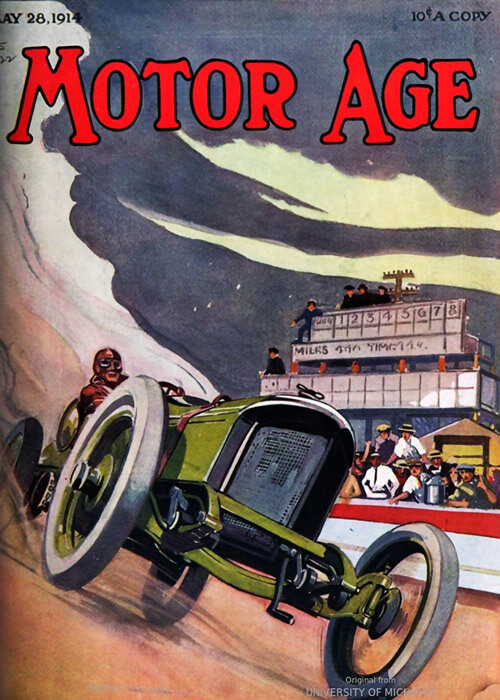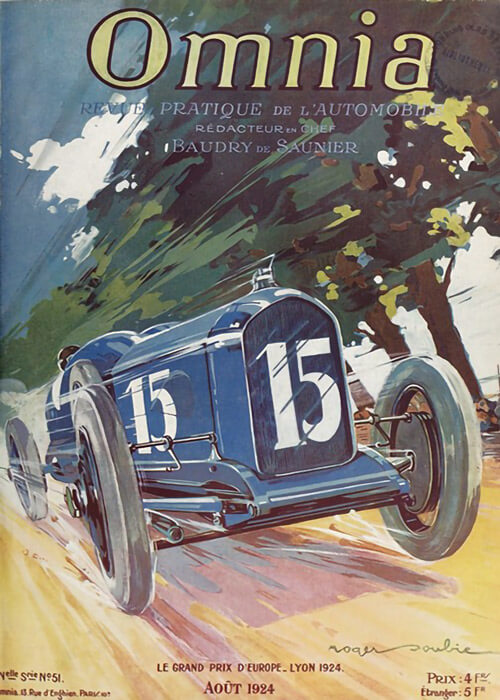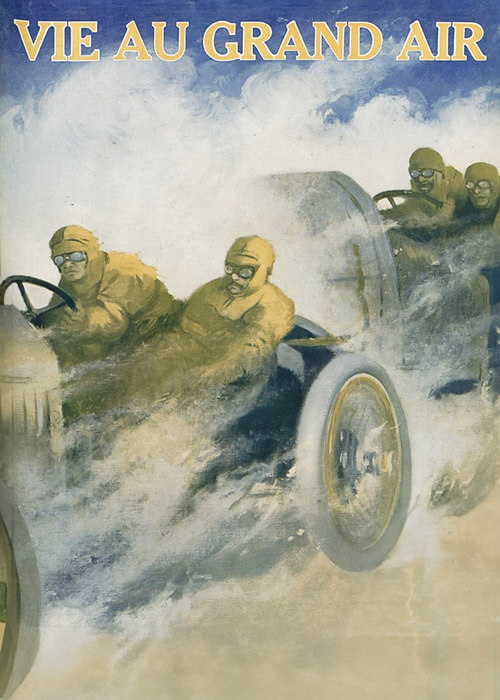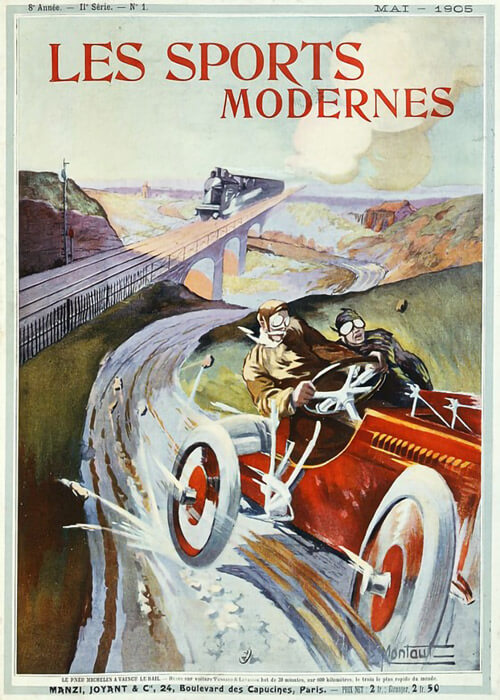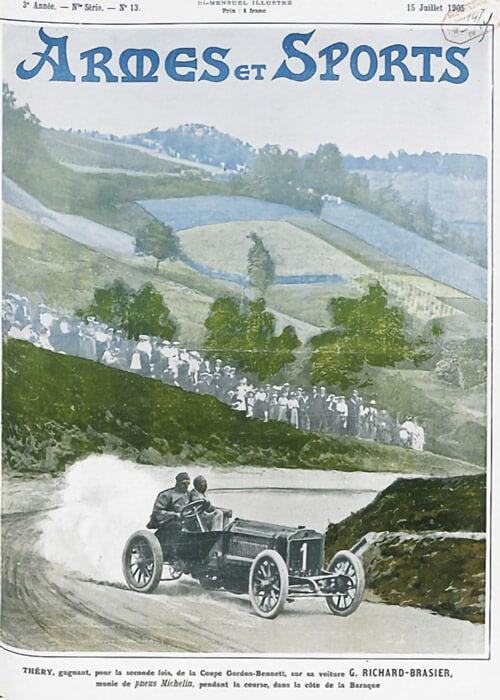The 1925 European Grand Prix was the first international race on the Spa-Francorchamps track. The race was won by Antonio Ascari in the Alfa-Romeo P2, laying the foundation for their 1925 world chanmpionship, which he himself sadly was not to whitness. This article shows the enthousiasm of the Italian press for their industry.
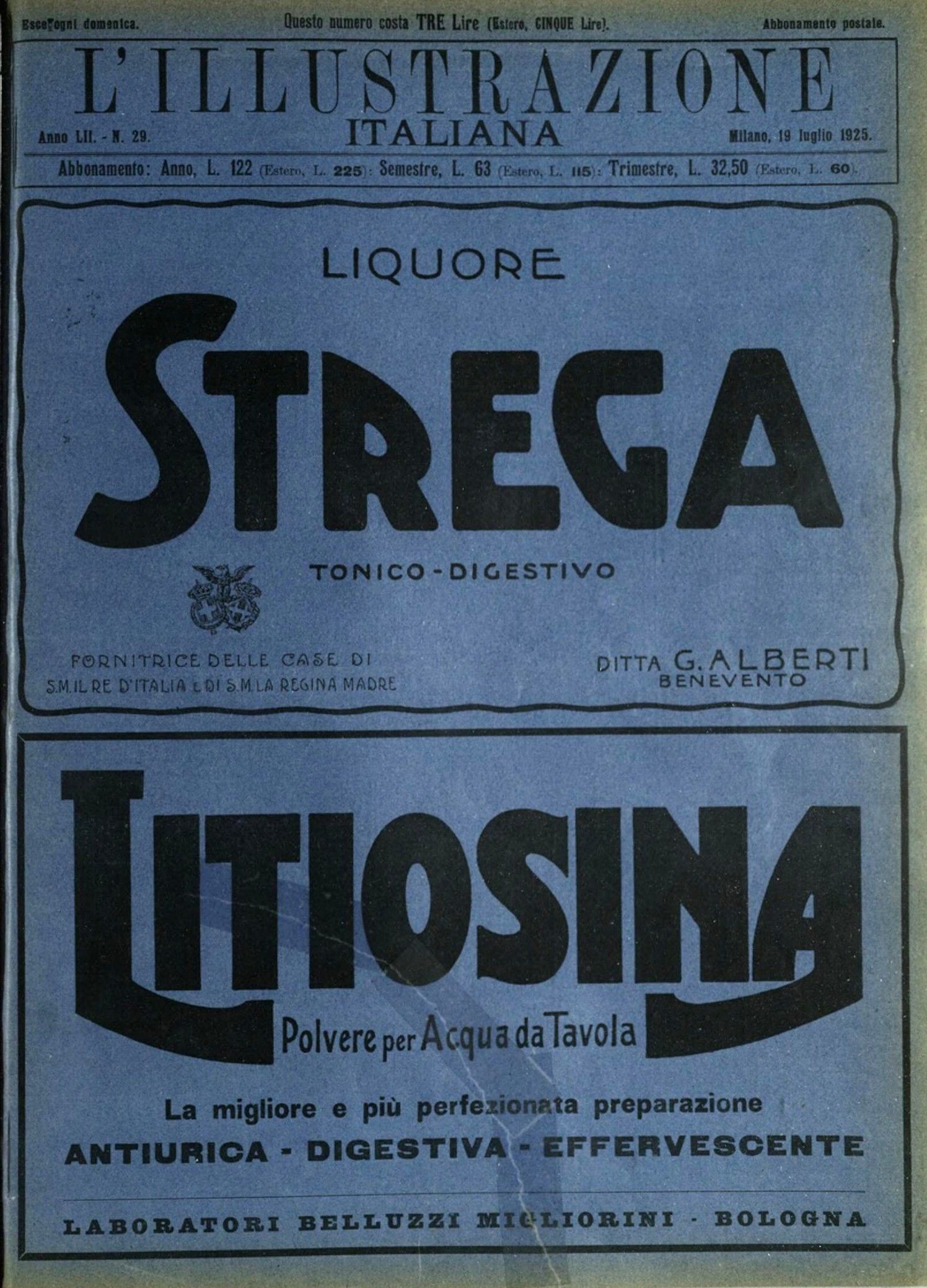
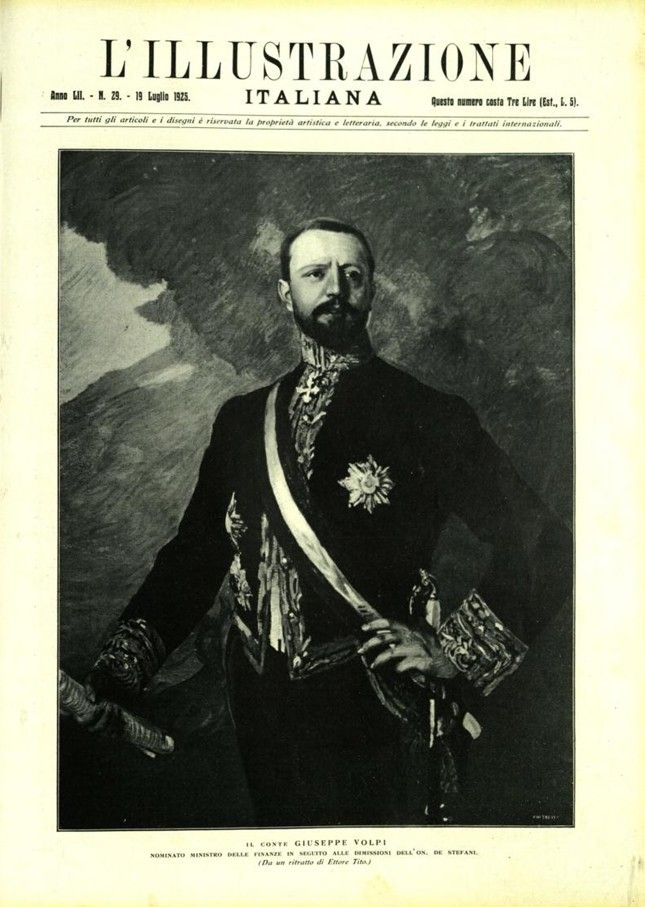
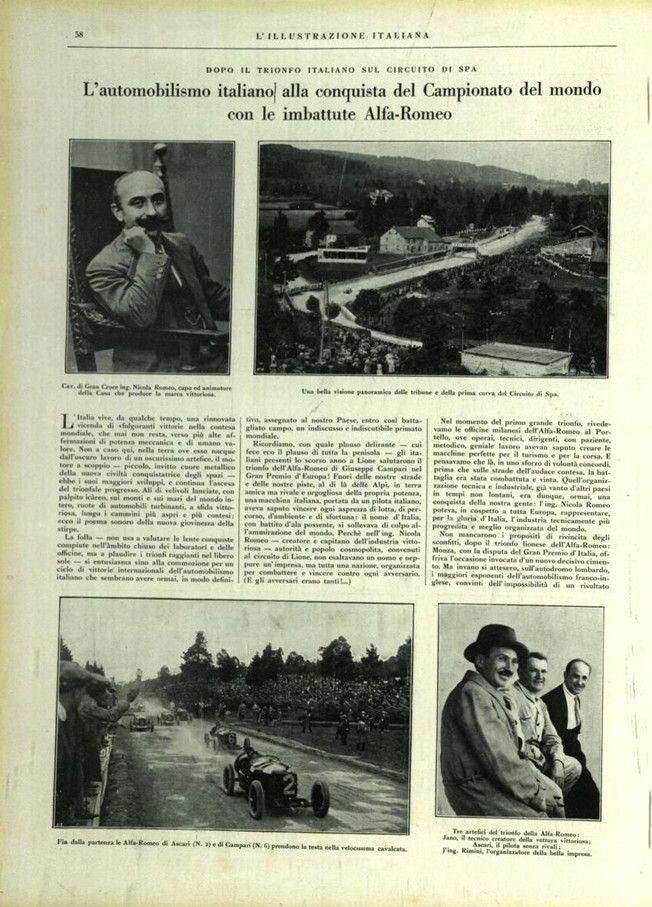
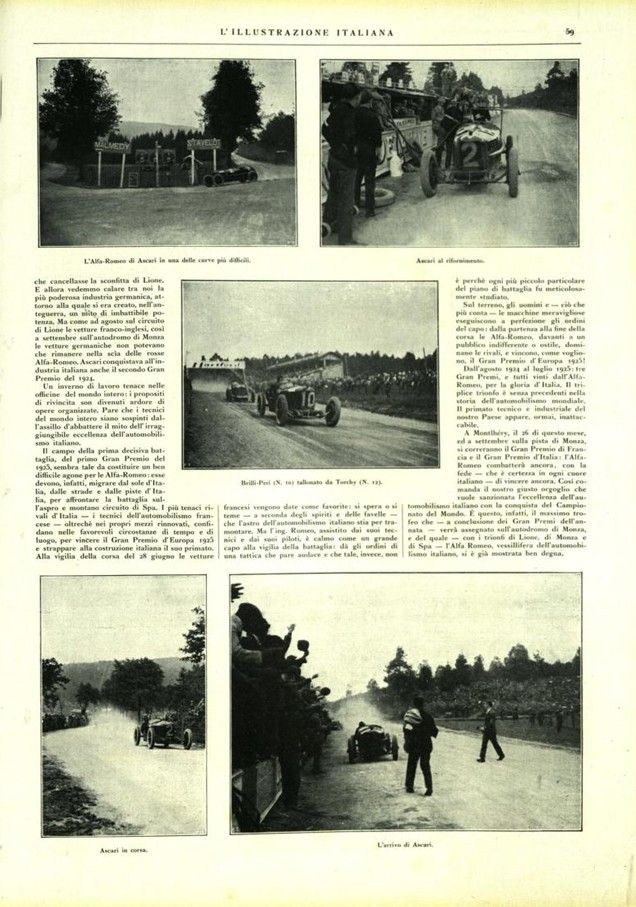
Text and fotos with courtesy of Internet Archive, www.archive.org compiled by motorracinghistory.com
L’Illustrazione Italiana, Anno LII, N. 29, 19 luglio 1925
DOPO IL TRIONFO ITALIANO SUL CIRCUITO DI SPA
L’automobilismo italiano alla conquista del Campionato del mondo con le imbattute Alfa-Romeo
L’Italia vive, da qualche tempo, una rinnovata vicenda di «folgoranti vittorie nella contesa mondiale, che mai non resta, verso più alte affermazioni di potenza meccanica e di umano valore. Non a caso qui, nella terra ove esso nacque dall’oscuro lavoro di un oscurissimo artefice, il motore a scoppio – piccolo, invitto cuore metallico della nuova civiltà conquistatrice degli spazi – ebbe i suoi maggiori sviluppi, e continua l’ascesa del trionfale progresso. Ali di velivoli lanciate, con palpito icàreo, sui monti e sui mari del mondo intero, ruote di automobili turbinanti, a sfida vittoriosa, lungo i cammini più aspri e più contesi: ecco il poema sonoro della nuova giovinezza della stirpe.
La folla – non usa a valutare le lente conquiste compiute nell’ambito chiuso dei laboratori e delle officine, ma a plaudire i trionfi raggianti nel libero sole – si entusiasma sino alla commozione per un ciclo di vittorie internazionali dell’automobilismo italiano che sembrano avere ormai, in modo definitivo, assegnato al nostro Paese, entro così battagliato campo, un indiscusso e indiscutibile primato mondiale.
Ricordiamo, con quale plauso delirante – cui fece eco il plauso di tutta la penisola – gli italiani presenti lo scorso anno a Lione salutarono il trionfo dell’Alfa-Romeo di Giuseppe Campari nel Gran Premio d’Europa! Fuori delle nostre strade e delle nostre piste, al di là delle Alpi, in terra amica ma rivale e orgogliosa della propria potenza, una macchina italiana, portata da un pilota italiano, aveva saputo vincere ogni asprezza di lotta, di percorso, d’ambiente e di sfortuna: il nome d’Italia, con battito d’ala possente, si sollevava di colpo all’ammirazione del mondo, Perché nell’ing. Nicola Romeo – creatore e capitano dell’industria vittoriosa – autorità e popolo cosmopolita, convenuti al circuito di Lione, non esaltavano un uomo e neppure un’impresa, ma tutta una nazione, organizzata per combattere e vincere contro ogni avversario. (E gli avversari erano tanti !… )
Nel momento del primo grande trionfo, rivedevamo le officine milanesi dell’Alfa-Romeo al Portello, ove operai, tecnici, dirigenti, con paziente, metodico, geniale lavoro avevano saputo creare le macchine perfette per il turismo e per la corsa. E pensavamo che là, in uno sforzo di volontà concordi, prima che sulle strade dell’audace contesa, la battaglia era stata combattuta e vinta. Quell’organizzazione tecnica e industriale, già vanto d’altri paesi in tempi non lontani, era dunque, ormai, una conquista della nostra gente: l’ing. Nicola Romeo poteva, in cospetto a tutta Europa, rappresentare, per la gloria d’Italia, l’industria tecnicamente più progredita e meglio organizzata del mondo.
Non mancarono i propositi di rivincita degli sconfitti, dopo il trionfo lionese dell’Alfa-Romeo: Monza, con la disputa del Gran Premio d‘ Italia, offriva l’occasione invocata d’un nuovo decisivo cimento. Ma invano si attesero, sull’autodromo lombardo, i maggiori esponenti dell’automobilismo franco-inglese, convinti dell’impossibilità di un risultato che cancellasse la sconfitta di Lione. E allora vedemmo calare tra noi la più poderosa industria germanica, attorno alla quale si era creato, nell’anteguerra, un mito di imbattibile potenza. Ma come ad agosto sul circuito di Lione le vetture franco-inglesi, così a settembre sull’autodromo di Monza le vetture germaniche non potevano che rimanere nella scia delle rosse Alfa-Romeo. Ascari conquistava all’industria italiana anche il secondo Gran Premio del 1924.
Un inverno di lavoro tenace nelle officine del mondo intero: i propositi di rivincita son divenuti ardore di opere organizzate. Pare che i tecnici del mondo intero siano sospinti dall’assillo d’abbattere il mito dell’irraggiungibile eccellenza dell’automobilismo italiano.
Il campo della prima decisiva battaglia, del primo Gran Premio del 1925, sembra tale da costituire un ben difficile agone per le Alfa-Romeo: esse devono, infatti, migrare dal sole d’Italia, dalle strade e dalle piste d‘ Italia, per affrontare la battaglia sull’aspro e montano circuito di Spa. I più tenaci rivali d’Italia – i tecnici dell’automobilismo francese – oltreché nei propri mezzi rinnovati, confidano nelle favorevoli circostanze di tempo e di luogo, per vincere il Gran Premio d’Europa 1925 e strappare alla costruzione italiana il suo primato.
Alla vigilia della corsa del 28 giugno le vetture francesi vengono date come favorite: si spera o si teme – a seconda degli spiriti e delle favelle – che l’astro dell’automobilismo italiano stia per tra-montare. Ma l’Ing. Romeo, assistito dai suoi tecnici e dai suoi piloti, e calmo come un grande capo alla vigilia della battaglia: dà gli ordini di una tattica che pare audace e che tale, invece, non è perché ogni più piccolo particolare del piano di battaglia fu meticolosamente studiato.
Sul terreno, gli uomini e – ciò che più conta – le macchine meravigliose eseguiscono a perfezione gli ordini del capo: dalla partenza alla fine della corsa le Alfa-Romeo, davanti a un pubblico indifferente o ostile, dominano le rivali, e vincono, come vogliono, il Gran Premio d’Europa 1925!
Dall’agosto 1924 al luglio 1925; tre Gran Premi, e tutti vinti dall’Alfa-Romeo, per la gloria d’Italia, Il triplice trionfo è senza precedenti nella storia dell’automobilismo mondiale. Il primato tecnico e industriale del nostro Paese appare, ormai, inattaccabile.
A Montlhéry, il 26 di questo mese, ed a settembre sulla pista di Monza, si correranno il Gran Premio di Francia e il Gran Premio d’Italia: l’Alfa-Romeo combatterà ancora, con la fede – che è certezza in ogni cuore italiano – di vincere ancora. Così comanda il nostro giusto orgoglio che vuole sanzionata l’eccellenza dell’automobilismo italiano con la conquista del Campionato del Mondo. E questo, infatti, il massimo trofeo che – a conclusione dei Gran Premi dell’annata – verrà assegnato sull’autodromo di Monza, e del quale – con i trionfi di Lione, di Monza e di Spa – I’ Alfa Romeo, vessillifera dell’automobilismo italiano, si è già mostrata ben degna.
Fotos.
Cav. di Gran Croce ing. Nicola Romeo, capo ed animatore della Casa che produce la marca vittoriosa.
Una bella visione panoramica delle tribune e della prima curva del Circuito di Spa.
Fin dalla partenza le Alfa-Romeo di Ascari (N. 2) e di Campari (N. 6) prendono la testa nella velocissima cavalcata.
Tre artefici del trionfo della Alfa-Romeo: Jano, il tecnico creatore della vettura vittoriosa; Ascari, il pilota senza rivali; l’Ing. Rimini, l’organizzatore della bella impresa.
L’Alfa-Romeo di Ascari in una curve più difficili.
Ascari al rifornimento. – Brilli-Peri (N. 10) tallonato da Torchy (N. 12).
Ascari in corsa. – L’arrivo di Ascari.


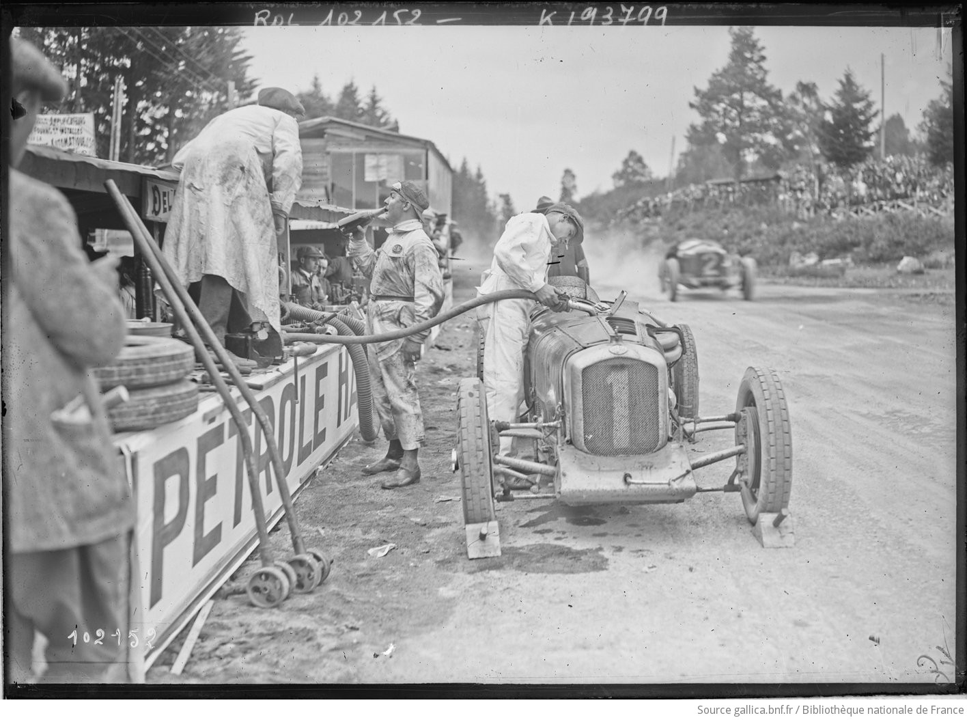
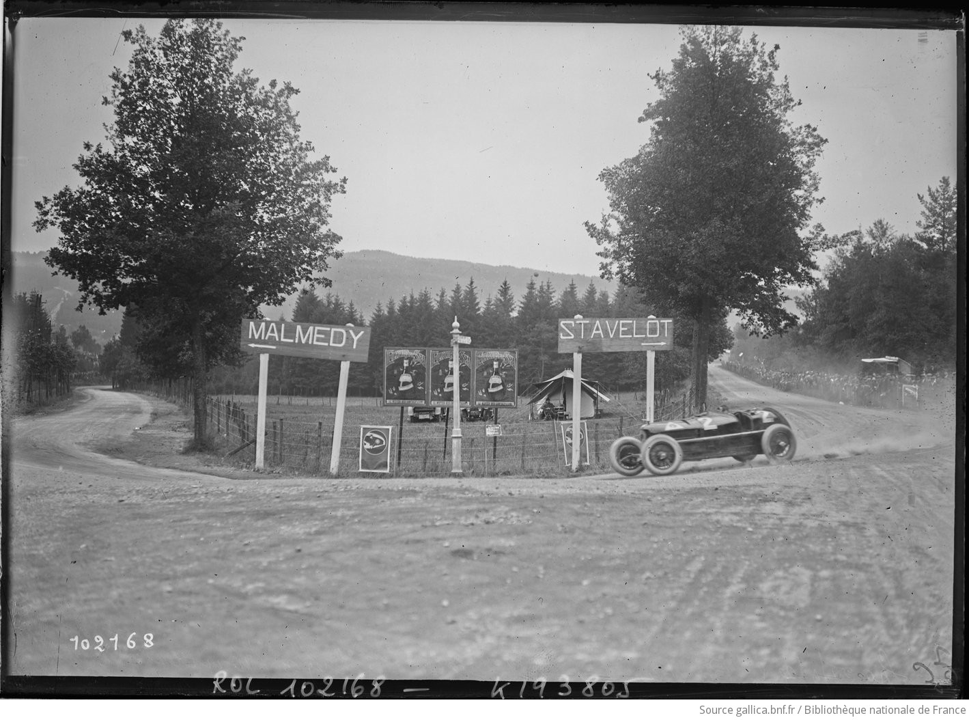
Translation by DeepL.com 25.04.2025 (Cliché ~ foto)
L’Illustrazione Italiana Volume LII, No. 29, 19 July 1925
AFTER THE ITALIAN TRIUMPH AT THE SPA CIRCUIT
Italian motor racing conquers the World Championship with the unbeaten Alfa-Romeo
For some time now, Italy has been experiencing a renewed series of “dazzling victories in the world arena, which never fails to achieve greater heights of mechanical power and human value. It is no coincidence that here, in the land where it was born from the obscure work of an obscure craftsman, the internal combustion engine – a small, invincible metal heart of the new civilization conquering space – had its greatest developments, and continues its triumphant progress. Wings of aircraft launched, with Icarian throbs, over the mountains and seas of the whole world, wheels of cars whirling in victorious challenge along the most rugged and contested roads: this is the sonorous poem of the new youth of the race.
The crowd – unaccustomed to evaluating the slow achievements made in the closed environment of laboratories and workshops, but accustomed to applauding triumphs in the open sun – is moved to tears by a series of international victories in motor racing that seem to have definitively assigned our country, in such a hard-fought field, an undisputed and unquestionable world primacy.
We remember the delirious applause — echoed throughout the peninsula — with which the Italians present last year in Lyon greeted the triumph of Giuseppe Campari’s Alfa Romeo in the European Grand Prix! Outside our roads and tracks, beyond the Alps, in a friendly but rival land proud of its power, an Italian car, driven by an Italian driver, had overcome every hardship of the race, the track, the environment, and bad luck: the name of Italy, with a mighty flap of its wings, rose suddenly to the admiration of the world. Because in Eng. Nicola Romeo — creator and captain of the victorious industry — authority and cosmopolitan people, gathered at the Lyon circuit, were not exalting a man or even an enterprise, but an entire nation, organized to fight and win against any opponent. (And there were many opponents!)
From the moment of the first great triumph, we saw again the Milanese workshops of Alfa Romeo at Portello, where workers, technicians, and managers, with patient, methodical, and ingenious work, had been able to create the perfect cars for tourism and racing. And we thought that there, in a concerted effort of will, before the battle was fought and won on the roads of daring competition, the battle had already been fought and won. That technical and industrial organization, once the pride of other countries in the not-too-distant past, was now an achievement of our people: engineer Nicola Romeo could, in the presence of the whole of Europe, represent, for the glory of Italy, the most technically advanced and best organized industry in the world.
There was no lack of plans for revenge on the part of the defeated after Alfa Romeo’s triumph in Lyon: Monza, with the Italian Grand Prix, offered the opportunity for a new decisive test. But the leading figures of French and British motor racing waited in vain at the Lombardy racetrack, convinced that it would be impossible to achieve a result that would erase the defeat in Lyon. And so we saw the most powerful German industry descend upon us, around which a myth of unbeatable power had been created in the pre-war period. But just as in August on the Lyon circuit, the French and British cars were unable to keep up with the red Alfa Romeos on the Monza racetrack in September. Ascari also won the second Grand Prix of 1924 for Italian industry.
A winter of hard work in workshops around the world: the desire for revenge became a burning desire for organized action. It seemed that engineers around the world were driven by the urge to destroy the myth of the unattainable excellence of Italian motor racing.
The field for the first decisive battle, the first Grand Prix of 1925, seemed to be a very difficult one for Alfa-Romeo: they had to migrate from the Italian sun, from the roads and tracks of Italy, to face battle on the harsh and mountainous Spa circuit. Italy’s most tenacious rivals, the French motor racing engineers, were confident not only in their revamped vehicles but also in the favorable circumstances of time and place to win the 1925 European Grand Prix and snatch the Italian primacy.
On the eve of the race on June 28, the French cars were considered favorites: it was hoped or feared – depending on one’s mood and opinion – that the star of Italian motor racing was about to set. But Romeo, assisted by his technicians and drivers, was as calm as a great leader on the eve of battle: he gave orders for a tactic that seemed daring but was not, because every tiny detail of the battle plan had been meticulously studied.
On the track, the men and, more importantly, the marvelous cars carried out their boss’s orders to perfection: from start to finish, the Alfa Romeos dominated their rivals in front of an indifferent or hostile crowd and won the 1925 European Grand Prix as they intended!
From August 1924 to July 1925, three Grand Prix races were won by Alfa Romeo, bringing glory to Italy. This triple triumph was unprecedented in the history of world motor racing. Our country’s technical and industrial supremacy now seemed unassailable.
On the 26th of this month at Montlhéry, and in September on the Monza track, the French Grand Prix and the Italian Grand Prix will be held: Alfa-Romeo will fight again, with the faith – which is a certainty in every Italian heart – that it will win again. This is what our just pride demands, which wants the excellence of Italian motor racing to be sanctioned with the conquest of the World Championship. This is, in fact, the highest trophy that – at the end of the Grand Prix season – will be awarded at the Monza racetrack, and which – with the triumphs in Lyon, Monza, and Spa – Alfa Romeo, the standard-bearer of Italian motor racing, has already proven itself worthy.
Photos.
Cav. di Gran Croce Nicola Romeo, head and driving force behind the company that produces the victorious brand.
A beautiful panoramic view of the grandstands and the first corner of the Spa Circuit.
Right from the start, the Alfa Romeos driven by Ascari (No. 2) and Campari (No. 6) take the lead in the fast-paced race.
Three architects of Alfa Romeo’s triumph: Jano, the engineer who designed the winning car; Ascari, the unrivaled driver; and Rimini, the organizer of this great feat.
Ascari’s Alfa Romeo in one of the most difficult corners.
Ascari refueling. – Brilli-Peri (No. 10) closely followed by Torchy (No. 12).
Ascari in the race. – Ascari’s arrival.
